临床护士心理弹性的现状研究
- 格式:pdf
- 大小:146.01 KB
- 文档页数:3
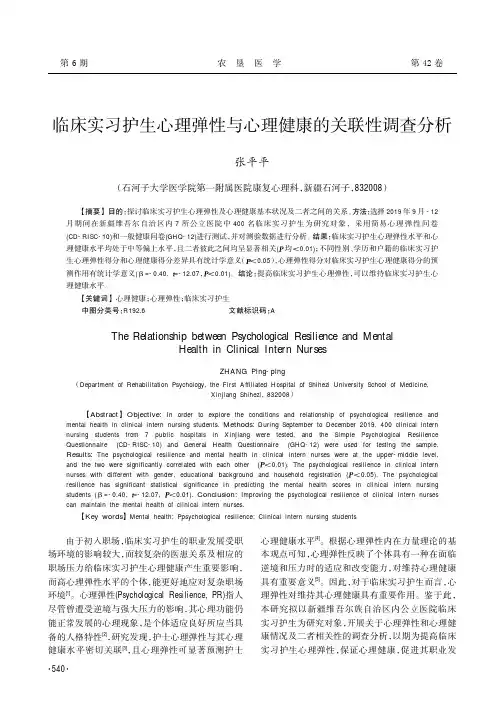
第6期农垦医学第42卷由于初入职场,临床实习护生的职业发展受职场环境的影响较大,而较复杂的医患关系及相应的职场压力给临床实习护生心理健康产生重要影响,而高心理弹性水平的个体,能更好地应对复杂职场环境[1]。
心理弹性(Psychological Resilience,PR)指人尽管曾遭受逆境与强大压力的影响,其心理功能仍能正常发展的心理现象,是个体适应良好所应当具备的人格特性[2],研究发现,护士心理弹性与其心理健康水平密切关联[3],且心理弹性可显著预测护士心理健康水平[4]。
根据心理弹性内在力量理论的基本观点可知,心理弹性反映了个体具有一种在面临逆境和压力时的适应和改变能力,对维持心理健康具有重要意义[5]。
因此,对于临床实习护生而言,心理弹性对维持其心理健康具有重要作用。
鉴于此,本研究拟以新疆维吾尔族自治区内公立医院临床实习护生为研究对象,开展关于心理弹性和心理健康情况及二者相关性的调查分析,以期为提高临床实习护生心理弹性,保证心理健康,促进其职业发临床实习护生心理弹性与心理健康的关联性调查分析张平平(石河子大学医学院第一附属医院康复心理科,新疆石河子,832008)【摘要】目的:探讨临床实习护生心理弹性及心理健康基本状况及二者之间的关系。
方法:选择2019年9月-12月期间在新疆维吾尔自治区内7所公立医院中400名临床实习护生为研究对象,采用简易心理弹性问卷(CD-RISC-10)和一般健康问卷(GHQ-12)进行测试,并对测验数据进行分析。
结果:临床实习护生心理弹性水平和心理健康水平均处于中等偏上水平,且二者彼此之间均呈显著相关(均<0.01);不同性别、学历和户籍的临床实习护生心理弹性得分和心理健康得分差异具有统计学意义(<0.05),心理弹性得分对临床实习护生心理健康得分的预测作用有统计学意义(β=-0.40,=-12.07,<0.01)。
结论:提高临床实习护生心理弹性,可以维持临床实习护生心理健康水平。
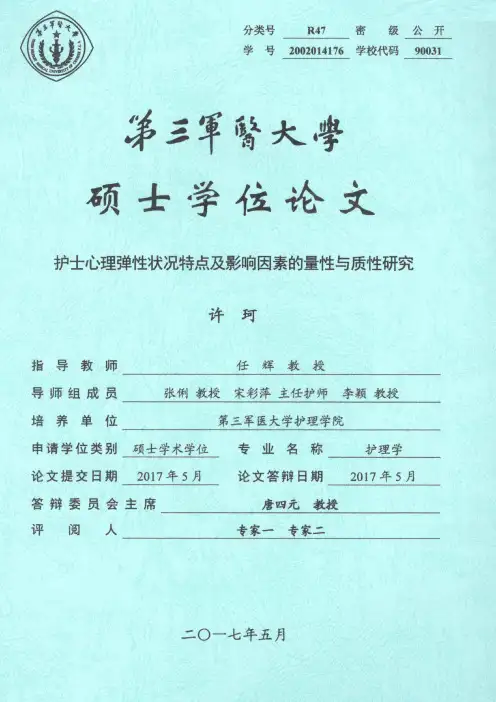
目录缩略语表 (1)英文摘要 (2)中文摘要 (6)论文正文护士心理弹性状况特点及影响因素的量性与质性研究 (9)第一章前言 (9)第二章护士心理弹性状况特点及其相关因素的量性研究 (14)2.1 研究对象 (14)2.2 研究方法 (14)2.3 结果 (16)2.4 讨论 (31)2.5 小结 (35)第三章护士高心理弹性形成原因的质性研究 (37)3.1 研究对象 (37)3.2 研究方法 (39)3.3 结果 (40)3.4 讨论 (47)3.5 小结 (48)全文总结 (50)参考文献 (53)文献综述护士心理弹性发生机制及其干预的研究进展 (59)参考文献 (65)附录 (69)研究生学习阶段发表论文和有关成果 (81)致谢 (82)缩略语表缩略词英文全称中文全称CD-RISC Connor-Davidson Resilience Scale 心理弹性量表Scale 流调用抑郁自评量表CES-D Survey-DepressionInventory-Human ServiceBurnoutMBI-HSS Maslach职业倦怠量表(服务行业版)SurveyCNSS Chinese Nurses Stressor Scale 护士工作压力源量表NJSS Nurses' Job Satisfaction Scale 护士工作满意度量表PSSS Perceived Social Support Scale 领悟社会支持量表SCSQ Simplified Coping Style Questionnaire 简易应对方式问卷Disorder 创伤后应激障碍PTSD PostStressTraumaticICU Intensive Care Unit 重症加强护理病房A quantity and quality study on the characteristics andinfluencing factors of nursing resilienceAbstractPurpose:This study regarded the clinical nurses as a whole to investigate the current status and the contributing factors of resilience, and to clarify the causes of high resilience of nurses, so as to improve the level of mental health of nurses in China and maintain the stability of nursing team,.in order to get the general rules of nursing resilience, to provide reference for the establishment of the resilience of nursing norm in China, to establish the resilience criteria for clinical nurses selection, and to provide theoretical basis for the implementation of the resilience training for the nursing staff.Methods:The first stage: using proportional stratified random sampling and cluster sampling combined with quantitative research methods. Firstly, on the stratification of 104 hospitals in Chongqing, which is divided into three layers: first class hospital, secondary hospital and teritary hospital. Using proportional stratified random sampling to select hospitals in each layer, and 1 teritary general hospital, 2 secondary general hospitals and 1 first class general hospital were selected eventually during May to September in 2016. Secondly, using cluster sampling to carry out the survey. A total of 2504 clinical nurses were recruited, and 2285 valid questionnaires were returned, the efficiency is 91.25%. The nurses were surveyed respectively with a pre-designed general information questionnaire, the Connor-Davidson resilience scale(CD-RISC), the Survey-Depression Scale(CES-D), the Maslach Burnout Inventory-Human Service Survey(MBI-HSS), the Chinese nurses stressor scale(CNSS), the Nurses' Job Satisfaction Scale, the Perceived Social Support Scale(PSSS) and the Simplified Coping style Questionnaire(SCSQ) to investigate the status and influencing factors of resilience in clinical nurses. Using SPSS version 19.0 to do statistical analysis. Data were expressed as mean±standard deviation. The t-test and One-Way ANOVA were used to analyze the effects of the general personnel information on the overall resilience.Spearman correlation was used to analyze the relationship between depression, job burnout, stress, job satisfaction, perceived social support, copying style and resilience. Multiple linear regression was used to determine the factors contributing to resilience. In all tests, a P﹤0.05 was interpreted to be statistically significant.The second stage: using qualitative research method. According to the results of the first stage, based on reviewing literature and consulting psychological experts, the screening standard of the nursing staff with high resilience was proposed (the score of the Resilience Scale ≥mean + standard deviation, the score of the Survey-Depression Scale ≤15 points, the score of the Chinese Nurses Stressor Scale>mean). Then semi-structured interviews were conducted on the method of using Colaizzi's to analyze the data to determine the theme, so as to clarify the reasons for the formation of nurses' high resilience.Results:1.The status of nursing resilienceThe score of nurses' resilience was 10 to 100, and the total score was 63.87±12.96, which was significantly lower than that of the community population in China 65.40 ±13.90.Resilience scores in three dimensions: tenacity 31.88±7.28, strength 22.32±4.66, optimism 9.67±2.40. The dimensional scores from high to low were as follows: strength 2.79±0.58, tenacity 2.45±0.56 and optimism 2.42±0.60.2.Characteristics of nursing resilienceDifferent demographic variables, such as age, marital status, fertility circumstance, whether the only child, education, academic title, administrative position, work experience, monthly income, shift mode, whether be awarded, hospital grade, intention to stay and self-perceived resilience impact on resilience at statistically significant level(P<0.05), However, no difference was found in gender, birth place and form of employment(P>0.05).3.The relationship between depression, job burnout, stress, job satisfaction, social support, coping style and nursing resilienceThe scores of depression, the sub-dimensions of job burnout, stress and its sub-dimensions were significantly correlated with resilience negatively(P<0.01). The scores of job satisfaction and its sub-dimensions, perceived social support and itssub-dimensions as well as the positive coping style were significantly correlated with resilience positively(P 0.01).4.Regression analysis of nursing resilienceThe administrative position, intention to stay, positive coping style, self-perceived degree of resilience, depression, emotional exhaustion, diminished personal accomplishment, depersonalization, work environment and equipment resources, work status as well as perceived social support contributed to resilience at statistically significant level, which could explain 35.5% of the variance.5.The causes for the formation of high resilienceThe subjects of high resilience quality interviews with nurses were as follows: The individual internal factors, social support and working environment. Among them, the individual internal factors involve: technical ability, effective coping, self regulation, high sense of occupation identity. Social support mainly includes three aspects: family support, friend support and colleague support. The working environment includes: effective security, welfare and job stability.Conclusions:1.The level of nursing resilience is low, which needs to be further improved.2.Demographic variables (age, marital status, fertility circumstance, whether the only child, education, academic title, administrative position, work experience, monthly income, shift mode, whether be awarded, hospital grade, intention to stay and self-perceived resilience) are identified to be the major contributing factors.3.Depression, job burnout, stress, job satisfaction, perceived social support and positive coping have significant effect on resilience. Depression, job burnout and stress are negatively correlated with resilience. Job satisfaction, perceived social support, positive coping are positively correlated with resilience.4.The administrative position, intention to stay, positive coping style, self-perceived degree of resilience, depression, emotional exhaustion, diminished personal accomplishment, depersonalization, work environment and equipment resources, work status as well as perceived social support can predict the level of nursing resilience.5.The main causes for the formation of the high resilience of nurses are individual internal factors, social support and working environment.Therefore, we should pay attention to the positive significance for the development of nursing resilience to the improvement of nurses' mental health status and the quality of nursing service. Enhance the resilience of nurses from different angles, so that nurses can do better and adapt well when facing the pressure of work and life.Key words: Clinical nursing; Resilience; Root Cause Analysis; Cross-sectional investigation; Qualitative research护士心理弹性状况特点及影响因素的量性与质性研究摘要目的本研究将临床护士作为整体来探讨其心理弹性规律特点及高心理弹性形成的原因,从而得到适用于临床各科室的护士心理弹性一般性规律,为建立我国护士心理弹性常模提供参考依据,填补我国在护士高心理弹性成因研究中的空白,为建立临床护士心理弹性选拔标准、对护理人员实施有针对性的心理弹性培训干预提供理论依据,进而达到改善我国临床护士心理健康状况,维护护理队伍稳定的目的。
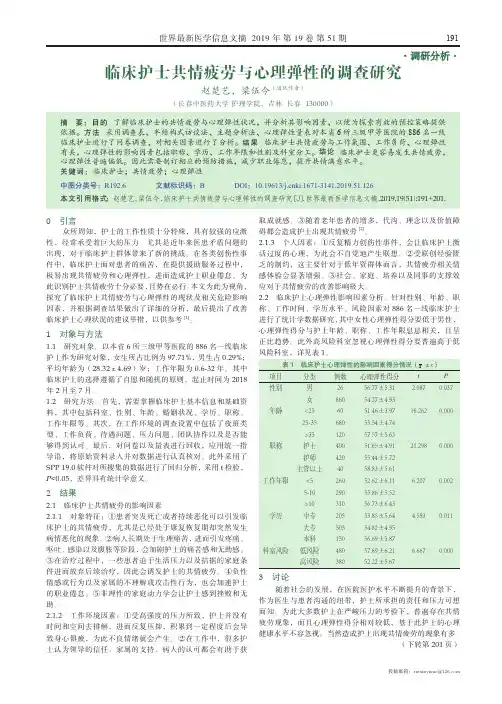
·调研分析·临床护士共情疲劳与心理弹性的调查研究赵楚艺,梁伍今(通讯作者)(长春中医药大学 护理学院,吉林 长春 130000)0 引言众所周知,护士的工作性质十分特殊,具有较强的应激性,经常承受着巨大的压力。
尤其是近年来医患矛盾问题的出现,对于临床护士群体带来了新的挑战。
在各类创伤性事件中,临床护士面对患者的痛苦,在提供援助服务过程中,极易出现共情疲劳和心理弹性,进而造成护士职业倦怠。
为此识别护士共情疲劳十分必要,且势在必行。
本文为此为视角,探究了临床护士共情疲劳与心理弹性的现状及相关危险影响因素,并根据调查结果做出了详细的分析,最后提出了改善临床护士心理状况的建议举措,以供参考[1]。
1 对象与方法1.1 研究对象。
以本省6所三级甲等医院的886名一线临床护士作为研究对象,女生所占比例为97.71%,男生占0.29%;平均年龄为(28.32±4.69)岁;工作年限为0.6-32年。
其中临床护士的选择遵循了自愿和随机的原则,起止时间为2018年2月至7月。
1.2 研究方法。
首先,需要掌握临床护士基本信息和基础资料,其中包括科室、性别、年龄、婚姻状况、学历、职称、工作年限等。
其次,在工作环境的调查设置中包括了夜班类型、工作负荷、待遇问题、压力问题、团队协作以及是否能够得到认可。
最后,对问卷以及量表进行回收,应用统一指导语,将原始资料录入并对数据进行认真核对。
此外采用了SPP 19.0软件对所搜集的数据进行了回归分析,采用t检验,P<0.05,差异具有统计学意义。
2 结果2.1 临床护士共情疲劳的影响因素2.1.1 对象特征:①患者突发死亡或者持续恶化可以引发临床护士的共情疲劳,尤其是已经处于康复恢复期却突然发生病情恶化的现象。
②病人长期处于生理痛苦,进而引发疼痛、呕吐、感染以及腹胀等阶段,会加剧护士的痛苦感和无助感。
③在治疗过程中,一些患者迫于生活压力以及拮据的家庭条件进而放弃后续治疗,因此会诱发护士的共情疲劳。

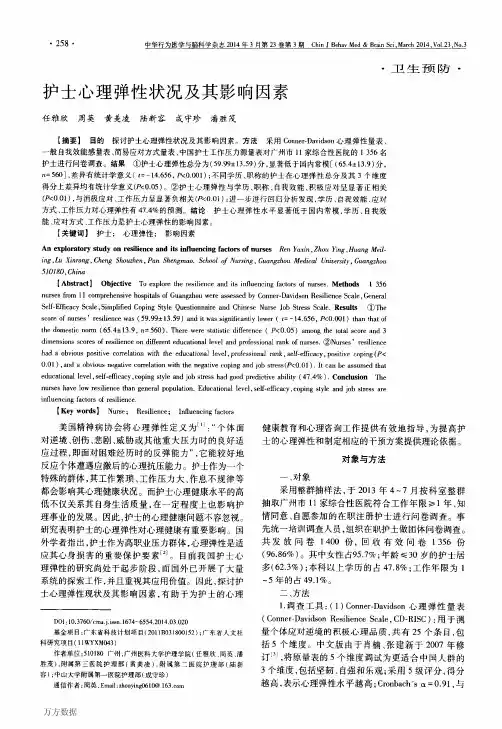
万方数据
万方数据
万方数据
护士心理弹性状况及其影响因素
作者:任雅欣, 周英, 黄美凌, 陆新容, 成守珍, 潘胜茂, Ren Yaxin, Zhou Ying, Huang Meiling,Lu Xinrong, Cheng Shouzhen, Pan Shengmao
作者单位:任雅欣,周英,潘胜茂,Ren Yaxin,Zhou Ying,Pan Shengmao(广州医科大学护理学院, 广州,510180), 黄美凌,Huang Meiling(广州医科大学附属第三医院护理部, 广州,510180), 陆新容,Lu Xinrong(广州医科大
学附属第二医院护理部, 广州,510180), 成守珍,Cheng Shouzhen(中山大学附属第一医院护理部)
刊名:
中华行为医学与脑科学杂志
英文刊名:Chinese Journal of Behavioral Medicine and Brain Science
年,卷(期):2014,23(3)
本文链接:/Periodical_zgxwyxkx201403020.aspx。
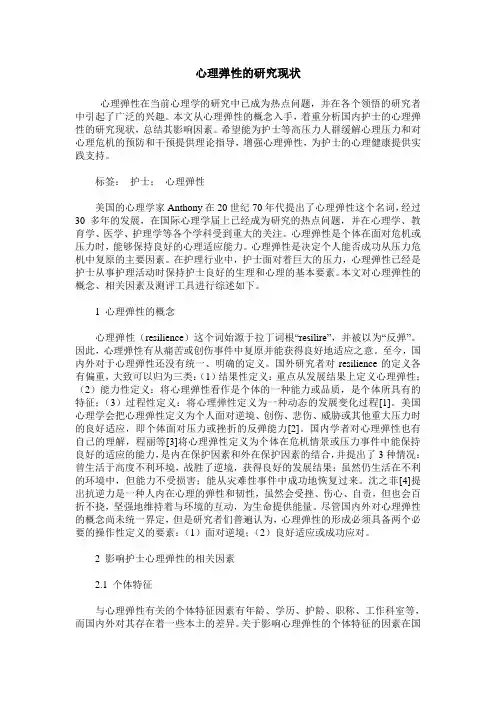
心理弹性的研究现状心理弹性在当前心理学的研究中已成为热点问题,并在各个领悟的研究者中引起了广泛的兴趣。
本文从心理弹性的概念入手,着重分析国内护士的心理弹性的研究现状,总结其影响因素。
希望能为护士等高压力人群缓解心理压力和对心理危机的预防和干预提供理论指导,增强心理弹性,为护士的心理健康提供实践支持。
标签:护士;心理弹性美国的心理学家Anthony在20世纪70年代提出了心理弹性这个名词,经过30多年的发展,在国际心理学届上已经成为研究的热点问题,并在心理学、教育学、医学、护理学等各个学科受到重大的关注。
心理弹性是个体在面对危机或压力时,能够保持良好的心理适应能力。
心理弹性是决定个人能否成功从压力危机中复原的主要因素。
在护理行业中,护士面对着巨大的压力,心理弹性已经是护士从事护理活动时保持护士良好的生理和心理的基本要素。
本文对心理弹性的概念、相关因素及测评工具进行综述如下。
1 心理弹性的概念心理弹性(resilience)这个词始源于拉丁词根“resilire”,并被以为“反弹”。
因此,心理弹性有从痛苦或创伤事件中复原并能获得良好地适应之意。
至今,国内外对于心理弹性还没有统一、明确的定义。
国外研究者对resilience的定义各有偏重,大致可以归为三类:(1)结果性定义:重点从发展结果上定义心理弹性;(2)能力性定义:将心理弹性看作是个体的一种能力或品质,是个体所具有的特征;(3)过程性定义:将心理弹性定义为一种动态的发展变化过程[1]。
美国心理学会把心理弹性定义为个人面对逆境、创伤、悲伤、威胁或其他重大压力时的良好适应,即个体面对压力或挫折的反弹能力[2]。
国内学者对心理弹性也有自己的理解,程丽等[3]将心理弹性定义为个体在危机情景或压力事件中能保持良好的适应的能力,是内在保护因素和外在保护因素的结合,并提出了3种情况:曾生活于高度不利环境,战胜了逆境,获得良好的发展结果;虽然仍生活在不利的环境中,但能力不受损害;能从灾难性事件中成功地恢复过来。
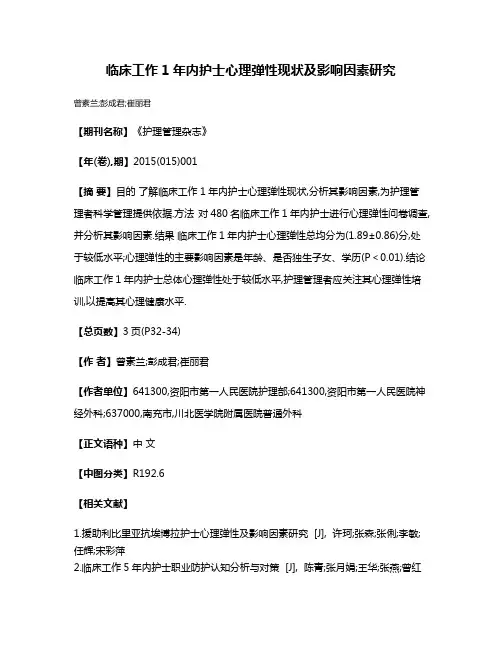
临床工作1年内护士心理弹性现状及影响因素研究
曾素兰;彭成君;崔丽君
【期刊名称】《护理管理杂志》
【年(卷),期】2015(015)001
【摘要】目的了解临床工作1年内护士心理弹性现状,分析其影响因素,为护理管理者科学管理提供依据.方法对480名临床工作1年内护士进行心理弹性问卷调查,并分析其影响因素.结果临床工作1年内护士心理弹性总均分为(1.89±0.86)分,处于较低水平;心理弹性的主要影响因素是年龄、是否独生子女、学历(P<0.01).结论临床工作1年内护士总体心理弹性处于较低水平,护理管理者应关注其心理弹性培训,以提高其心理健康水平.
【总页数】3页(P32-34)
【作者】曾素兰;彭成君;崔丽君
【作者单位】641300,资阳市第一人民医院护理部;641300,资阳市第一人民医院神经外科;637000,南充市,川北医学院附属医院普通外科
【正文语种】中文
【中图分类】R192.6
【相关文献】
1.援助利比里亚抗埃博拉护士心理弹性及影响因素研究 [J], 许珂;张森;张俐;李敏;任辉;宋彩萍
2.临床工作5年内护士职业防护认知分析与对策 [J], 陈青;张月娟;王华;张燕;曾红
伟
3.精神专科医院护士心理弹性状况及其影响因素研究 [J], 季加翠
4.三级综合性医院护士心理弹性现状及影响因素研究 [J], 黄琳琳; 郭小曼; 纪梓哲; 易琦峰; 林琳
5.抗击新冠肺炎疫情一线护士心理弹性现状及影响因素研究 [J], 陈姗;卢军;成沛玉;周丽丽;许静;郭姣;李玉翠;赵成岗
因版权原因,仅展示原文概要,查看原文内容请购买。
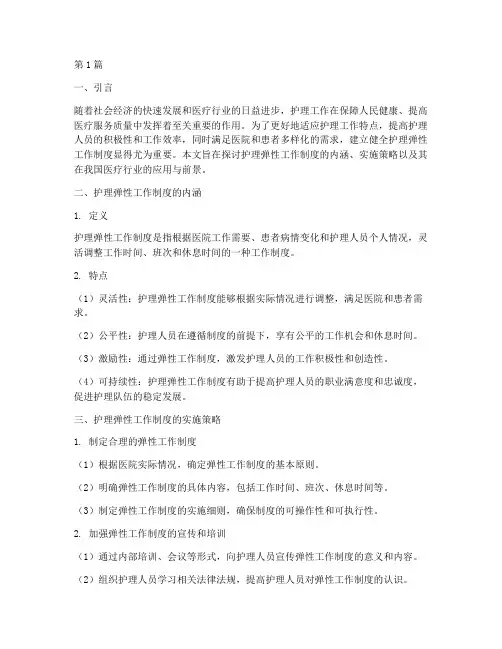
第1篇一、引言随着社会经济的快速发展和医疗行业的日益进步,护理工作在保障人民健康、提高医疗服务质量中发挥着至关重要的作用。
为了更好地适应护理工作特点,提高护理人员的积极性和工作效率,同时满足医院和患者多样化的需求,建立健全护理弹性工作制度显得尤为重要。
本文旨在探讨护理弹性工作制度的内涵、实施策略以及其在我国医疗行业的应用与前景。
二、护理弹性工作制度的内涵1. 定义护理弹性工作制度是指根据医院工作需要、患者病情变化和护理人员个人情况,灵活调整工作时间、班次和休息时间的一种工作制度。
2. 特点(1)灵活性:护理弹性工作制度能够根据实际情况进行调整,满足医院和患者需求。
(2)公平性:护理人员在遵循制度的前提下,享有公平的工作机会和休息时间。
(3)激励性:通过弹性工作制度,激发护理人员的工作积极性和创造性。
(4)可持续性:护理弹性工作制度有助于提高护理人员的职业满意度和忠诚度,促进护理队伍的稳定发展。
三、护理弹性工作制度的实施策略1. 制定合理的弹性工作制度(1)根据医院实际情况,确定弹性工作制度的基本原则。
(2)明确弹性工作制度的具体内容,包括工作时间、班次、休息时间等。
(3)制定弹性工作制度的实施细则,确保制度的可操作性和可执行性。
2. 加强弹性工作制度的宣传和培训(1)通过内部培训、会议等形式,向护理人员宣传弹性工作制度的意义和内容。
(2)组织护理人员学习相关法律法规,提高护理人员对弹性工作制度的认识。
3. 完善弹性工作制度的监督与考核(1)设立专门的监督机构,负责对弹性工作制度的实施情况进行监督检查。
(2)建立健全考核机制,对护理人员的工作表现进行评价,确保弹性工作制度的公平性和激励性。
4. 优化人力资源配置(1)根据医院工作需要,合理调整护理人员的工作班次和休息时间。
(2)加强对护理人员的培训,提高护理人员的综合素质和业务能力。
5. 关注护理人员身心健康(1)定期组织护理人员参加体检,关注护理人员的身心健康。
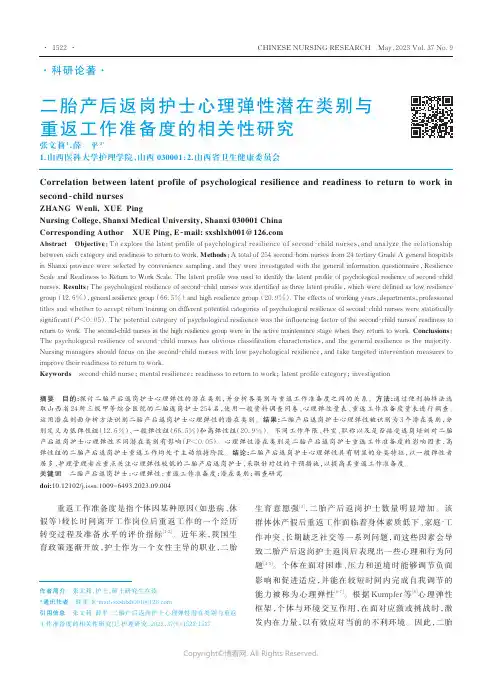
二胎产后返岗护士心理弹性潜在类别与重返工作准备度的相关性研究张文莉1,薛平2*1.山西医科大学护理学院,山西 030001;2.山西省卫生健康委员会Correlation between latent profile of psychological resilience and readiness to return to work in second⁃child nursesZHANG Wenli, XUE PingNursing College, Shanxi Medical University, Shanxi 030001 ChinaCorresponding Author XUEPing,E⁃mail:******************Abstract Objective:To explore the latent profile of psychological resilience of second⁃child nurses,and analyze the relationship between each category and readiness to return to work.Methods:A total of 254 second⁃born nurses from 24 tertiary Grade A general hospitals in Shanxi province were selected by convenience sampling,and they were investigated with the general information questionnaire,Resilience Scale and Readiness to Return to Work Scale.The latent profile was used to identify the latent profile of psychological resilience of second⁃child nurses.Results:The psychological resilience of second⁃child nurses was identified as three latent profile,which were defined as low resilience group (12.6%),general resilience group (66.5%) and high resilience group (20.9%).The effects of working years,departments,professional titles and whether to accept return training on different potential categories of psychological resilience of second⁃child nurses were statistically significant(P<0.05).The potential category of psychological resilience was the influencing factor of the second⁃child nurses' readiness to return to work.The second-child nurses in the high resilience group were in the active maintenance stage when they return to work.Conclusions:The psychological resilience of second⁃child nurses has obvious classification characteristics,and the general resilience is the majority. Nursing managers should focus on the second⁃child nurses with low psychological resilience,and take targeted intervention measures to improve their readiness to return to work.Keywords second⁃child nurse; mental resilience; readiness to return to work; latent profile category; investigation摘要目的:探讨二胎产后返岗护士心理弹性的潜在类别,并分析各类别与重返工作准备度之间的关系。
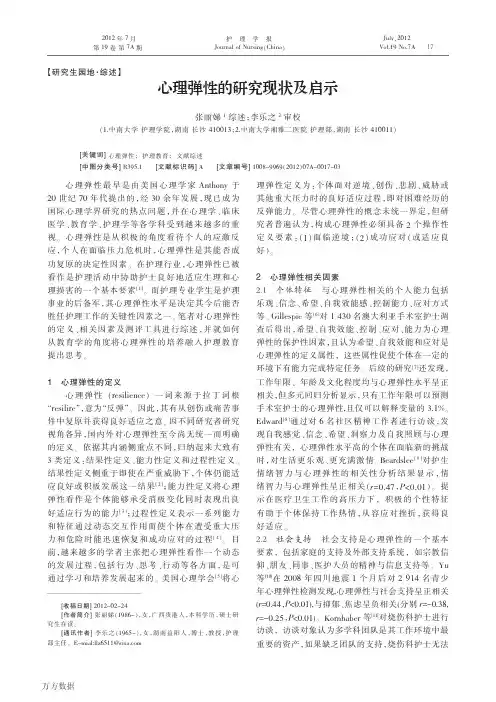
2012年7月护理学报July,2012第19卷第7A期Journal of Nursing(China)Vol.19No.7A【研究生园地·综述】心理弹性的研究现状及启示张丽娣1综述;李乐之2审校(1.中南大学护理学院,湖南长沙410013;2.中南大学湘雅二医院护理部,湖南长沙410011)[关键词]心理弹性;护理教育;文献综述[中图分类号]R395.1[文献标识码]A[文章编号]1008-9969(2012)07A-0017-03心理弹性最早是由美国心理学家Anthony于20世纪70年代提出的,经30余年发展,现已成为国际心理学界研究的热点问题,并在心理学、临床医学、教育学、护理学等各学科受到越来越多的重视。
心理弹性是从积极的角度看待个人的应激反应,个人在面临压力危机时,心理弹性是其能否成功复原的决定性因素。
在护理行业,心理弹性已被看作是护理活动中协助护士良好地适应生理和心理损害的一个基本要素[1]。
而护理专业学生是护理事业的后备军,其心理弹性水平是决定其今后能否胜任护理工作的关键性因素之一。
笔者对心理弹性的定义、相关因素及测评工具进行综述,并就如何从教育学的角度将心理弹性的培养融入护理教育提出思考。
1心理弹性的定义心理弹性(resilience)一词来源于拉丁词根“resilire”,意为“反弹”。
因此,其有从创伤或痛苦事件中复原并获得良好适应之意。
因不同研究者研究视角各异,国内外对心理弹性至今尚无统一而明确的定义。
依据其内涵侧重点不同,归纳起来大致有3类定义:结果性定义、能力性定义和过程性定义。
结果性定义侧重于即使在严重威胁下,个体仍能适应良好或积极发展这一结果[2];能力性定义将心理弹性看作是个体能够承受消极变化同时表现出良好适应行为的能力[3];过程性定义表示一系列能力和特征通过动态交互作用而使个体在遭受重大压力和危险时能迅速恢复和成功应对的过程[4]。
目前,越来越多的学者主张把心理弹性看作一个动态的发展过程,包括行为、思考、行动等各方面,是可通过学习和培养发展起来的。
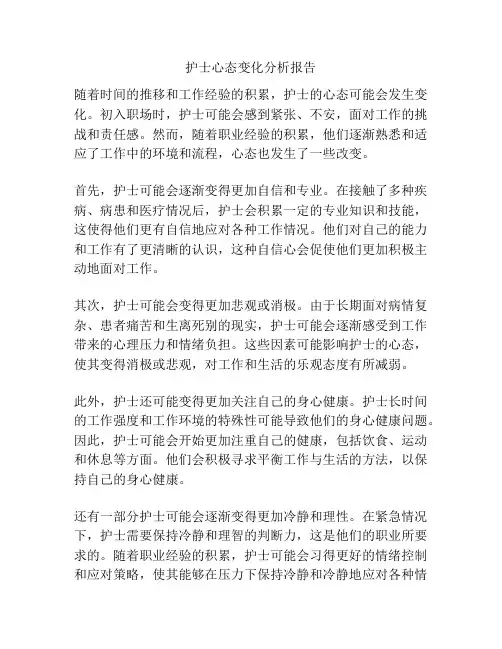
护士心态变化分析报告随着时间的推移和工作经验的积累,护士的心态可能会发生变化。
初入职场时,护士可能会感到紧张、不安,面对工作的挑战和责任感。
然而,随着职业经验的积累,他们逐渐熟悉和适应了工作中的环境和流程,心态也发生了一些改变。
首先,护士可能会逐渐变得更加自信和专业。
在接触了多种疾病、病患和医疗情况后,护士会积累一定的专业知识和技能,这使得他们更有自信地应对各种工作情况。
他们对自己的能力和工作有了更清晰的认识,这种自信心会促使他们更加积极主动地面对工作。
其次,护士可能会变得更加悲观或消极。
由于长期面对病情复杂、患者痛苦和生离死别的现实,护士可能会逐渐感受到工作带来的心理压力和情绪负担。
这些因素可能影响护士的心态,使其变得消极或悲观,对工作和生活的乐观态度有所减弱。
此外,护士还可能变得更加关注自己的身心健康。
护士长时间的工作强度和工作环境的特殊性可能导致他们的身心健康问题。
因此,护士可能会开始更加注重自己的健康,包括饮食、运动和休息等方面。
他们会积极寻求平衡工作与生活的方法,以保持自己的身心健康。
还有一部分护士可能会逐渐变得更加冷静和理性。
在紧急情况下,护士需要保持冷静和理智的判断力,这是他们的职业所要求的。
随着职业经验的积累,护士可能会习得更好的情绪控制和应对策略,使其能够在压力下保持冷静和冷静地应对各种情况。
总之,护士的心态在职业生涯中可能会发生多种变化。
从初入职场的紧张不安到逐渐成熟和自信,再到可能的悲观或消极,护士的心态会受到工作环境和经历的影响。
然而,对于护士来说,保持积极的心态对于应对工作中的挑战和压力至关重要。
只有健康的心态才能帮助护士提供更好的护理服务。
临床护士人格特质与心理契约的相关性2延边大学法学院吉林延吉 1362003延边大学工学院吉林延吉 136200课题项目:吉林省国家级大学生创新创业训练计划项目(项目编号202210184008)【摘要】目的:调查临床护士人格特质和心理契约现状,并探讨其相关性。
方法:于2022年9~10月便利抽样法选择吉林省二级、三级甲等医院临床护士261例,采用一般资料、中国大五人格调查问卷简版和心理契约违背量表使用问卷星对其进行调查。
结果:261例临床护士的人格特质各维度得分从高到低依次是宜人性(36.57±2.21)分,严谨性(36.35±2.88)分,外向性(33.34±3.23)分,开放性(32.80±3.19),神经质(18.16±2.99)分,心理契约总分为(72.87±8.11)分。
临床护士人格特质中的严谨性、开放性、外向性、宜人性与心理契约呈正相关(r=0.443~0.330,P<0.01),神经质与心理契约呈负相关(r=-0.363,P<0.01)。
结论临床护士人格特质与心理契约具有相关性。
护理管理者需针对不同的人格特质采取合理措施,以提高心理契约水平。
【关键词】临床护士;人格特质;心理契约心理契约是指在某一特定工作背景下,组织与员工之间相互义务的、期望双方承诺实现的内隐的信念[[1]]。
护士作为医疗卫生体系的中坚力量,既往研究表明,心理契约是影响护士工作投入及职业倦怠的重要因素,可直观反映护士对现有工作的满意程度,与护士离职倾向息息相关[[2],[3],[4],[5]]。
而人格特质作为个体内在且持久的特质系统,可以促进个体行为的一致性,影响人类的外显行为和感知[[6]]。
能否通过个体的外显人格觉察内隐心理,以巩固其心理契约,目前尚未见其针对护士群体的报道。
本研究旨在调查临床护士人格特质和心理契约现状,探索人格特质对心理契约的影响。
心理弹性在急诊护士应激(压力)反应与应对方式之间的中介效应周 露,李 婷,周成莉,管 琴,朱晓玲摘要 目的:探讨突发公共卫生事件下,急诊护士心理弹性㊁应激(压力)反应㊁应对方式的现状及其之间的关系㊂方法:采用便利抽样法于2023年1月 3月选取四川省5所三级甲等医院的280名急诊科护士作为研究对象,使用一般资料调查表㊁心理弹性量表㊁应激(压力)量表和简易应对方式量表进行调查㊂结果:心理弹性㊁应激(压力)反应㊁简易应对方式总分分别为(63.26ʃ19.11)分㊁(52.13ʃ24.43)分㊁(29.10ʃ9.60)分;相关分析显示,心理弹性与应激(压力)反应呈负相关(P <0.01);心理弹性与积极应对呈正相关(P <0.01),心理弹性与消极应对相关性不显著(P >0.05);应激(压力)反应与积极应对呈负相关(P <0.01);中介效应分析显示,心理弹性在应激(压力)反应与积极应对之间起部分中介作用,效应值为-0.196,效应占比为51.17%㊂结论:心理弹性是急诊护士应激(压力)反应与积极应对方式之间的中介变量,管理者可以通过提高急诊护士心理弹性水平来促进其在应激事件下选择积极应对方式㊂关键词 急诊护士;心理弹性;应激(压力)反应;应对方式;中介效应K e yw o r d s e m e r g e n c y n u r s e s ;p s y c h o l o g i c a l r e s i l i e n c e ;s t r e s s r e s p o n s e ;c o p i n g s t y l e s ;m e d i a t i n g e f f e c t s d o i :10.12104/j.i s s n .1674-4748.2023.35.027 近年来,全球公共卫生事件频发,其不可预见㊁突然爆发,给医疗体系带来了巨大的冲击㊂急诊护士作为应对突发卫生事件的主要救援力量,发挥着巨大的作用㊂然而面对突发的事件以及不确定的风险,急诊护士相较于其他科室护士存在更多的心理应激源,极易出现临床应激反应㊂应激(压力)反应是个体与环境之间的特殊关系,当刺激物作用于机体后出现心理反应的过程[1-2]㊂心理弹性是指当个体遭受艰辛㊁处于困境或其他异乎寻常的事件时能够很好应对,并最终适应的过程[3]㊂应对方式是指个体处于应激环境或遭受应激事件时,有意识且灵活的适应方式,以便调节应激所带来的情绪或躯体反应[4-5]㊂既往研究多探寻应激(压力)反应㊁心理弹性㊁应对方式两两之间的关系,因此本研究旨在调查急诊护士应激(压力)反应㊁心理弹性㊁应对方式现状及其三者间的作用机制,以期为急诊管理工作提出新的理论依据和视角㊂1 对象与方法1.1 研究对象采用便利抽样法,于2023年1月 3月选取四川基金项目 大理大学博士科研项目,编号:D F Y 20220302㊂作者简介 周露,主管护师,硕士研究生在读,单位:671600,大理大学护理学院,646000,西南医科大学附属医院;李婷㊁周成莉单位:646000,西南医科大学附属医院;管琴单位:671600,大理大学护理学院;朱晓玲单位:大理大学附属第一医院㊂引用信息 周露,李婷,周成莉,等.心理弹性在急诊护士应激(压力)反应与应对方式之间的中介效应[J ].全科护理,2023,21(35):5002-5005.省5所三级甲等医院的急诊护士作为研究对象㊂纳入标准:有护士执业资格证书;在急诊科工作ȡ1年;知情同意自愿参与本研究㊂排除标准:实习㊁进修㊁规范化培训㊁轮转护士;调查期间不在岗㊂根据研究工具自变量个数的10~20倍进行样本估算[6],本研究自变量共12个,考虑可能存在10%~20%的无效问卷,需132~288人;本研究实际纳入280名急诊护士㊂1.2 方法1.2.1 一般资料调查表由研究者自行设计,内容包括性别㊁年龄㊁是否参与过突发公共卫生事件救援㊁是否进行相关培训㊁面对突发公共卫生事件是否恐惧等5个项目㊂1.2.2 心理弹性量表采用于肖楠等[7]翻译并修订的心理弹性量表,该量表共25个条目,包含坚韧㊁力量和乐观3个维度㊂采用L i k e r t 5级计分,从 0=从不 到 4=几乎总是,分数越高表示心理弹性水平越高㊂该量表被多项研究证实具有良好的信效度㊂本次研究中该量表的C r o n b a c h 's α系数为0.924㊂1.2.3 简易应对方式量表采用解亚宁[8]1998年编制的简易应对方式量表,该量表共包含20个题项,由2个分量表:积极应对(12个条目)和消极应对(8个条目)构成㊂采用L i k e r t 4级计分, 0=不采取 到 3=经常采取 ,该量表具有良好的信效度㊂本次研究中该量表的C r o n b a c h 's α系数为0.886㊂1.2.4 应激压力反应量表㊃2005㊃C H I N E S E G E N E R A L P R A C T I C E N U R S I N G D e c e m b e r 2023V o l .21N o .35采用钟霞等[9]设计的应激压力量表,该量表包含3个维度,即情绪反应㊁躯体反应和行为反应,共有28个条目,其中情绪反应12个条目,躯体反应8个条目,行为反应6个条目以及其他2个条目㊂采用L i k e r t5级计分, 1=不是 到 5=是 ㊂量表得分越高表示应激压力反应越高㊂以往研究表明该量表具有良好的信效度㊂本次研究中该量表的C r o n b a c h'sα系数为0.960㊂1.3调查方法本研究应用 问卷星 将上述问卷编制成电子问卷,征得各医院急诊科护士长同意后发放电子问卷链接,急诊护士知情同意后自行填写问卷㊂本次研究共发放调查问卷288份,收回有效问卷280份,有效率为97.2%㊂本研究已获得医学伦理委员审批(N O.1213/ 2022),所获信息将严格保密仅做研究使用㊂1.4统计学方法采用S P S S26.0软件进行数据分析,采用P e a r s o n 探讨相关关系及A m o s28.0构建结构方程模型分析心理弹性在应激(压力)反应与积极应对方式之间的中介作用,采用B o o t s t r a p方法进行中介效应显著性检验㊂双侧检验,检验水准α=0.05㊂2结果2.1不同人口学特征护士一般资料280名急诊护士中,男46人,女234人;年龄(30.99ʃ8.35)岁;参与突发卫生事件相关培训人员为213人,有救援经历的人数为130人,面对突发公共卫生事件感到恐惧人数有84人㊂2.2急诊护士心理弹性㊁应激(压力)反应㊁简易应对方式量表得分情况280名急诊护士心理弹性总分为(63.26ʃ19.11)分,坚韧㊁力量㊁乐观维度得分分别为(32.58ʃ10.22)分㊁(21.24ʃ6.46)分㊁(9.44ʃ3.27)分;简易应对方式总分(29.10ʃ9.60)分,积极应对及消极应对维度得分分别为(20.52ʃ7.71)分㊁(20.52ʃ7.71)分;应激(压力)反应总分为(52.13ʃ24.43)分,躯体反应㊁情绪反应㊁行为反应维度得分分别为(15.29ʃ7.21)分㊁(21.62ʃ11.14)分㊁(11.56ʃ5.32)分㊂2.3急诊护士心理弹性㊁应激(压力)反应㊁简易应对方式的相关性分析本研究相关性分析显示,心理弹性与应激(压力)反应呈负相关(P<0.01);心理弹性与积极应对呈正相关(P<0.01),心理弹性与消极应对相关性不显著(P>0.05);应激(压力)反应与积极应对呈负相关(P<0.01),应激(压力)反应与消极应对呈正相关(P<0.01),见表1㊂表1急诊护士心理弹性㊁应激(压力)反应㊁简易应对方式的相关性分析(r值)项目应激压力躯体反应情绪反应行为反应心理弹性坚韧维度力量维度乐观维度积极应对消极应对应激压力1.000①躯体反应0.969①1.000①情绪反应0.982①0.924①1.000①行为反应0.960①0.899①0.924①1.000①心理弹性-0.589①-0.567①-0.573①-0.578①1.000①坚韧维度-0.567①-0.544①-0.556①-0.551①0.978①1.000①力量维度-0.589①-0.571①-0.567①-0.582①0.964①0.905①1.000①乐观维度-0.506①-0.483①-0.493①-0.507①0.882①0.804①0.833①1.000①积极应对-0.504①-0.483①-0.494①-0.487①0.568①0.557①0.551①0.487①1.000①消极应对0.245①0.235①0.252①0.220①-0.113-0.113-0.137②-0.0370.153②1.000① ①P<0.01,②P<0.05㊂2.4心理弹性在应激(压力)反应与积极应对之间的中介作用采用A m o s28.0软件以应激(压力)反应为自变量,心理弹性为中介变量,积极应对为因变量,构建结构方程模型(见图1),结果显示模型拟合指标良好(见表2)㊂进一步采用B o o t s t r a p法进行验证,取样数为5000,置信区间为95%㊂结果显示,应激(压力)反应对积极应对的直接效应为-0.19,应激(压力)反应通过心理弹性对积极应对的间接效应为-0.196,占总效应的51.05%,此路径的95%置信区间为(-0.276,-0.127),不包含0,表明此间接效应显著㊂见表3㊂㊃3005㊃全科护理2023年12月第21卷第35期图1心理弹性在应激(压力)反应与积极应对之间中介效应结构模型表2心理弹性在应激(压力)反应与积极应对之间的中介作用模型拟合指标拟合指标χ2/d f R E S E A C F I T L I A G F I N F I I F I G F I 指标值0.8190.0001.0000.9990.9770.9951.0000.990参考值<5.00<0.08>0.90>0.90>0.90>0.90>0.90>0.90注:卡方/自由度(χ2/d f);近似误差均方根(R M S E A);相对拟合度指数(C F I);塔克-刘易斯指数(T L I);调试后适配度指数(A G F I);规范拟合指数(N F I);增值适配度指数(I F I);拟合优度指数(G F I)㊂表3中介效应检验及B o o t s t r a p分析结果效应路径效应值95%C I占总效应量(%)直接效应应激(压力)反应ң积极应对-0.189[-0.285,-0.090]48.83间接效应应激(压力)反应ң心理弹性ң积极应对-0.196[-0.276,-0.127]51.17总效应-0.383[-0.457,-0.306]100.003讨论3.1急诊护士应激(压力)反应㊁心理弹性及积极应对的现状分析本研究结果显示,急诊护士应激(压力)反应为(52.13ʃ24.43)分,这与关文洁等[10]研究结果相近,可能因为:调查期间正值 新十条 发布,防控政策优化后,各地疫情进入新阶段,病人数量激增大量涌入医院,急诊科作为医院防控的首要关卡,面临着巨大的挑战㊂而突增的工作量以及感染风险的加大,使急诊护士持续处于高负荷应激状态,应激心理理论指出,当发生外部环境因素刺激时,个体常常会出现轻度的焦虑和恐惧,但长期处于这种应激下往往会引起个体认知和情绪问题,诱发非适应性行为[11]㊂因此,护理管理者要重视急诊护士的工作环境,同时要特别关注其情绪问题,给予适当的心理疏导,提高心理承受力,减轻其心理应激反应㊂本研究中心理弹性得分(63.26ʃ19.11)分,低于国内常模(65.22ʃ13.88)分[12],表明急诊护士心理资本水平较差,分析可能原因是:长期处于高压应激环境,部分人员会出现不同程度的负性心理情绪,同时急诊科是医院里节奏最快最忙碌的科室,护理人员所要求的技能㊁知识往往比较苛刻,因此部分急诊护士心理素质可能较为脆弱㊂与许远等[13]的研究结果大致相同,提示急诊护士更倾向于采用积极应对方式去面对困境㊂这可能与国家关心关爱一线医务人员相关政策的下放有关,特别是对急危重症人员临床工作的认可[14],会让急诊护士受到极大的鼓舞,激励其有意识㊁有目的调节自身精神状态,进而在面对突发应激事件中能够主动选择积极的应对方式㊂3.2急诊护士应激(压力)反应㊁心理弹性及积极应对相关性本研究相关性分析结果显示,急诊护士应激(压力)反应与心理弹性呈负相关(P<0.01),即急诊护士应激(压力)反应过大其心理弹性水平就越低,这可能是个体受到应激事件后,除了生理反应上激素的增多,还主要表现在个体的情绪和认知上的变化[15],这种变化打破了原有的心理平衡,若应激越大,个体就无法调动心理资源去平衡这种应激,心理弹性水平就会逐渐下降最终导致崩塌[16]㊂本研究中应激(压力)反应与积极应对呈负相关(P<0.01),与消极应对呈正相关(P<0.01),相关研究表明应对方式是人们面对生活中的各种应激源常用的对策㊂对于解决应激事件,以问题为中心的人会采取积极的方式去应对应激源,寻㊃4005㊃C H I N E S E G E N E R A L P R A C T I C E N U R S I N G D e c e m b e r2023V o l.21N o.35找解决问题的方式,减少负性情绪[17]㊂而以情绪为中心的人通常会采取逃避的方式去应对应激源,这部分人会任其发展,利用负性情绪去避免接触应激事件,进而加剧了压力反应的滋生[18-19]㊂提示应激(压力)反应在应对方式的选择上有一个度,取决于个体当下的选择㊂本研究中心理弹性与积极应对呈正相关(P<0.01)㊂这也表明了心理弹性强调的是个体积极应对的心理能力,它是个体拥有的一种保护性因素,当个人处于高危的应激环境中,心理弹性作为适应困境的力量源泉,会带领个体转危为安,实现蜕变适应发展[20]㊂3.3心理弹性在急诊护士应激(压力)反应与积极应对之间的中介作用本研究中介效应路径分析显示:应激(压力)反应可以直接影响急诊护士积极应对的方式,同时也可以通过心理弹性间接影响积极应对方式㊂表明心理弹性是应激(压力)反应与积极应对的中介变量,其效应值为51.17%㊂三元交互理论指出应激(压力)反应是环境㊁个人㊁行为因素的共同作用,当个体面对环境中的应激事件,通过心理弹性的正向反馈,不断增加个体的信念以达到重构自身内部稳态,这种原始的内在能量能有效地促进个体采取积极的方式去保护和治愈身心[21]㊂而突发的公共卫生事件作为医疗系统中庞大的应激源,往往带给护士的冲击是巨大的,然而每个个体都会有不同的认知和特质,对待相同的应激刺激所做的反应也有所不同[22],心理弹性水平较高的护士,通常思维和动机会正向调节其行为方式,唤醒身体去主动应对刺激,战胜突发事件㊂因此,提示护理管理者在遭遇突发公共卫生事件下,首先要运用心理学相关评估的方法,比如采用日常交流或单独访谈方法去提前评估急诊护士的应激(压力)反应,对于应激水平较高的护士要积极疏导㊁情感关怀,定期进行相关心理健康教育,让护士感受到组织带来的温暖,日常工作中管理层要多传递正面的情绪,减轻护士的心理负担,提高其抗压能力㊂同时组织还要密切关注急诊护士的心理水平状况,增强其应对突发公共卫生事件的风险意识,用科学理智的态度去对待应激事件,选择有利于缓冲应激的积极方式,协助急诊护士应对困境,适应变化㊂其次采用内外部环境中的保护性因素去提高急诊护士心理弹性水平,开展应激培训演练,教会护士运用周围资源去促进适应㊂另外也可以进行周期性的应对技能训练,使急诊护士在突发公共卫生事件发生时,能够采取更多的应对方式㊂最后,护理管理者应采用温度化的管理方式,灵活且有倾向性制定急诊相关政策,让急诊护士感受到组织的重视与温暖,提高职业认同感,滋生内在心理能源当突发公共卫生事件出现时,应激(压力)反应在强大的心理源泉下就会逐渐减弱,同时调节急诊护士的心理素质使其采取积极的应对方式去战胜这场危机㊂综上所述,应激(压力)反应会负向预测积极应对方式,心理弹性在应激(压力)反应与积极应对中间起部分中介作用,应激反应过大会导致个体采取消极的方式去应对应激事件,但如果提高个人的心理弹性水平就会激发其采取正向积极的方式去应对㊂由于本研究缺乏纵向研究与质性访谈,结果有一定局限性,未来研究可以加入上述两方法,以取得更加完善的结论㊂参考文献:[1] A L MH D AW I K A,A L A Z R A I A,K A N A A N S,e t a l.P o s t-s t r o k ed e p r e s s i o n,a n x i e t y,a n d s t r e s s s y m p t o m s a n d t h e i r a s s o c i a t e df a c t o r s:a c r o s s-s e c t i o n a l s t u d y[J].N e u r o p s y c h o l og i c a l R eh a bi l i t a t i o n,2020(3):1-14.[2]白利峰.基于E R P探究月经不调㊁压力觉知对女大学生应激反应的影响[D].咸阳:陕西中医药大学,2022.[3] W I N D L E,G I L L.W h a t i s r e s i l i e n c e?A r e v i e w a n d c o n c e p t a n a l y s i s[J].R e v i e w s i n C l i n i c a l G e r o n t o l o g y,2011,21(2):152-169.[4] B A U T I S T A R,R U N D L E-G O N Z A L E Z V,AWA D R G,e t a l.D e t e r m i n i n g t h e c o p i n g s t r a t e g i e s o f i n d i v i d u a l s w i t h e p i l e p s y[J].E p i l e p s y&B e h a v i o r E&B,2013,27(2):286-291.[5]王端卫.简易应对方式问卷的因子分析及应用[D].济南:山东大学,2014.[6]李静,刘宇.护理学研究方法[M].北京:人民卫生出版社,2012:50-54[7]于肖楠,张建新.自我韧性量表与C o n n o r-D a v i d s o n韧性量表的应用比较[J].心理科学,2007(5):1169-1171.[8]解亚宁.简易应对方式量表信度和效度的初步研究[J].中国临床心理学杂志,1998(2):53-54.[9]钟霞,姜乾金,钱丽菊,等.医务人员压力反应与社会支持㊁生活事件㊁应对方式的相关研究[J].中国临床心理学杂志,2005(1):70-72.[10]关文洁,聂岸柳,苏湘芬,等.新冠肺炎流行期急诊护士心理应激反应及相关因素[J].中国心理卫生杂志,2021,35(1):73-78.[11] L A Z A R U S R S,F O L KMA N S.S t r e s s,a p p r a i s a l a n d c o p i n g[J].C h i l d r e n's H e a l t h C a r e,2010,29(4):1.[12]赵妍.新冠疫情防控常态化下医务人员的心理弹性及相关因素研究[D].北京:北京大学医学部,2021.[13]许远,赵梅,唐新龙,等.新型冠状病毒肺炎流行期间医护人员心理健康与应对方式相关性研究[J].安徽医学,2020,41(4):368-371.[14]卢佳铭.海南省急诊医护人员离职意愿调查及其影响因素分析[D].海口:海南医学院,2021.[15]白利峰.基于E R P探究月经不调㊁压力觉知对女大学生应激反应的影响[D].咸阳:陕西中医药大学,2022.[16]张晓茹.急诊护士突发公共卫生事件应急能力与心理资本调查研究[D].太原:山西医科大学,2020.[17] W E I C,G A O J,C H E N L,e t a l.F a c t o r s a s s o c i a t e d w i t h p o s t-s t r o k e d e p r e s s i o n a n d e m o t i o n a l i n c o n t i n e n c e:l e s i o n l o c a t i o n a n dc o p i n g s t y l e s[J].T h e I n t e r n a t i o n a l J o u r n a l o f N e u r o s c i e n c e,2016,126(7):623-629.[18]江维军.N I C U转出脑卒中病人家属疾病不确定感对迁移应激的影响[D].海口:海南医学院,2021.[19]徐明川,张悦.首批抗击新型冠状病毒感染肺炎的临床一线支援护士的心理状况调査[J].护理研究,2020,34(3):368-370. [20]S M I T H J L,H O L L I N G E R-S M I T H L.S a v o r i n g,r e s i l i e n c e,a n dp s y c h o l o g i c a l w e l l-b e i n g i n o l d e r a d u l t s[J].A g i n g&M e n t a lH e a l t h,2015,19(3):192-200.[21] V A N D K M A,F A N T I N M,K R A E V I,e t a l.I m p a i r e dh i p p o c a m p a l n e u r o l i g i n-2f u n c t i o n b y c h r o n i c s t r e s s o r s y n t h e t i cp e p t i d e t r e a t m e n t i s l i n k e d t o s o c i a l d e f i c i t s a n d i n c r e a s e da g g r e s s i o n[J].N e u r o p s y c h o p h a r m a c o l o g y O f f i c i a l P ub l ic a t i o n o ft h e A m e r i c a n C o l l e g e o f N e u r o p s y c h o p h a r m a c o l o g y,2014,39(5):1148-1158.[22] P A T R I C K J,D Y C K M,B R AM S T O N P.D e p r e s s i o n a n x i e t ys t r e s s s c a l e:i s i t v a l i d f o r c h i l d r e n a n d a d o l e s c e n t s?[J].J o u r n a l o f C l i n i c a l P s y c h o l o g y,2010,66(9):996-1007.(收稿日期:2023-05-26;修回日期:2023-12-06)(本文编辑郭海瑞)㊃5005㊃全科护理2023年12月第21卷第35期。
我国经历了非典、禽流感等突发公共卫生事件,最近的新冠肺炎也引起了恐慌。
在公共卫生事件下,护士的消极紧张心理应对往往只能带来工作和生活上的压抑和偏执,有良好的心理素质才能保证护理工作的顺利进行[1]。
Richardson[2]认为人们在面对困难与危机时,其心理韧性发挥出了有效而关键性的作用。
良好的心理韧性有助于护理者保持积极心态应对压力和挫折,提高工作效率。
本文通过对近10年来国内对于护理人员心理韧性研究,分析公共卫生事件下心理韧性的情况及相关影响因素,并思考和探讨提高护理人员心理韧性的一些有效举措,促进护理工作发展。
1心理韧性的概念心理韧性也叫心理弹性,原指物理上的概念,即物体受到压力时作出的反弹。
从心理学的角度来看,其显现了人在逆境中应对和抵抗的适应过程,是个体的一种品质和能力。
研究表明[3],对护理人员而言,在紧张高压的工作中良好适应以及积极有效地应对职业压力与挑战,心理韧性是必不可缺的要素。
2护士心理韧性研究现状2.1研究群体逐步扩展我国的研究相比国外起步要晚,近年来我国医疗事业迅速崛起,社会对于护理人员的重视度与认可感也得到提高,护士心理韧性的有关研究得到了不少学者的重视,成为护理领域的热点[4]。
而关注对象也不局限于临床护士,作为未来护理事业的继承者和建设者,各类学历层次的护理专业学生也成为了人们关心的对象,研究的群体不断扩展[5-7]。
2.2研究工具近几十年来,研究者们在心理学、社会科学、医疗等领域开展心理韧性研究,测量工具既可以用于白领上班族也可以用于普通农民,并没有刻意限定某一人群,因此对于护理行业需要选择科学而实用的工具量表,以量化研究结果,为后续工作提供依据[8]。
目前常突发公共卫生事件下护理人员心理韧性的研究及思考陈飞杰付洋洋▲杭州医学院,浙江杭州310053[摘要]突发公共卫生事件破坏性大,影响久远,国家不得不进入应急状态,作为医疗卫生机构的重要力量,全国各地的护理人员迅速加入了抗疫行动,协同所有一线工作者抗击疫情。
护士心理弹性状况分析摘要:目的:了解某医院护士的心理健康水平并采取相应的措施。
提高其整体心理健康水平,进而提高护士整体素质和临床护理服务质量。
调查方法:向研究对象发放问卷调查二维码,由其在20分钟内独自填写。
本研究共发放调查表202份,共回收有效调查表202份,有效回收率为100% 。
统计学方法:应用spss20.0 统计学软件进行数据分析。
计量资料采用x± s表示,组间比较行t检验或方差分析。
以p < 0.05为差异有统计学意义。
结果:本研究临床某医院的CD RISC得分均值为65.58分,高于国内常模心理弹性调查[3]结果65.4分,调查结果高于50分的理论中间值,高于国内调查分数。
结论:此次进行护士心理健康调查分析,某医院护士的弹性状况调查得分高于国内普通护士心理弹性状况调查得分。
表示护士有心理弹性水平较高,能够很好地应对临床工作中的各种压力。
针对个别心理弹性得分低的护士,管理者可根据护士实际情况帮助护士减压,减少护士工作量和不必要的考试,以减少护士压力。
关键词:护士心理健康;调查;弹性状况分析;美国心理学会将心理弹性定义为个体面对逆境、创伤、悲剧、威胁或其他重大压力时的良好适应过程,即面对困难经历时的反弹能力[1]。
心理弹性决定着人的心理抗压能力,心理弹性高的个体面对负面事件时心理创伤程度小,恢复迅速、应对成功率高。
护士由于工作的特殊性,可能给她们带来一些挫折或压力。
如不能积极应对,会给她们带来极大的精神困扰,产生一些心理问题,进而影响工作[2]。
本研究调查2021年某医院护士的心理弹性状况和影响因素,寻找提高心理弹性的有效方法,从而提高护理工作的效率和质量。
现报告如下。
1、对象与方法1.1研究对象:选取2021年4月某医院202名护士为研究对象。
1.2调查工具①一般情况调查表:内容包括研究对象的性别、年龄、学历。
② Connor Davidson心理弹性量表(CD RISC):量表由 Connor和 Davidson编制,Yu和ZHANG将其翻译并修订成中文版,共包含乐观(4个因子)、自强(8个因子)、坚韧(13个因子)3个维度,共25个因子。
天津市某三甲心血管专科医院护士心理弹性与职业倦怠相关性研究陈江琼;李然【摘要】目的::探讨天津市某三级甲等心血管专科医院护士的心理弹性、职业倦怠水平,并探究两者间的相关性,为改善护士心理弹性、减缓或降低职业倦怠提供有效依据和指导。
方法:采用便利抽样方法选取医院6大科室的护士共139名,采用由一般资料调查表、中文版职业倦怠量表( MBI-GS)、Connor和Davidson心理弹性量表( CD-RISC)所组成的问卷对其进行调查。
结果:心血管专科医院护士存在中度职业倦怠,心理弹性水平一般,职业倦怠与心理弹性存在显著的负相关关系( P<0.01)。
结论:心血管专科医院护士的心理弹性水平可以很好地预测其职业倦怠情况,应引起管理者关注。
【期刊名称】《齐鲁护理杂志》【年(卷),期】2015(000)015【总页数】4页(P69-71,72)【关键词】心血管;护士;职业倦怠;心理弹性【作者】陈江琼;李然【作者单位】天津医科大学研究生院天津市300070;天津泰达国际心血管病医院【正文语种】中文【中图分类】R192.6近年来有研究显示,我国的护士职业倦怠水平较高,如何提高护士的工作积极性,降低职业倦怠水平、延迟职业倦怠的产生已成为管理者关注的重点[1]。
在护理行业中,心理弹性已被看作是协助护士良好地适应生理和心理损害的一个基本要素,并且国内已有研究表明心理弹性与职业倦怠之间存在相关性,但其研究主要人群是企业员工[2-3]。
在现今的医疗大背景下,护士作为医院团队的重要组成部分,在工作中不得不承受着人力不足、工作繁重、精神压力大等问题。
因此,护士的心理健康问题及工作的效率已成为管理者关注的重点。
由于心血管疾病存在病情变化突然、致死率高等特点,作为心血管专科护士,其工作压力更为繁重[4]。
2013年12月~2014 年8月,我们对139名心血管专科医院护士的心理弹性、职业倦怠水平进行了调查,以探讨其相关性。